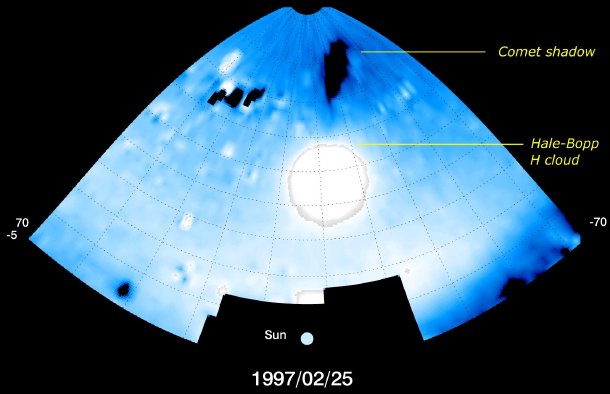A comet's shadow
|
Click on the image for a larger version. |
 |
Also available: 4-panel "poster" with 3 observations
and diagram: small,
large |
Caption: The image above shows the biggest shadow ever observed in our solar system, that of a comet projected on the sky behind it.
The SWAN instrument, short for Solar Wind Anisotropies, is used to map the whole sky in ultraviolet light. It sees a huge cloud of interstellar hydrogen that bathes the entire Solar System and interacts with the solar wind. The cloud is relatively tenuous - about 100 atoms per litre - yet it is thick enough to shine when illuminated by the Sun's ultraviolet light.
Although most of the hydrogen atoms in the Solar System blow in from interstellar space, comets are surrounded by large hydrogen clouds of their own. When comet Hale-Bopp flew near the Sun parading its 100-million-kilometre-long tail in 1997, SOHO was already in orbit. In SWAN observations from that time, the scientists have now spotted a remarkable feature - never before seen by astronomers - the elongated shadow, more than 150 million kilometres long, of a comet projected on the sky beyond the comet.
Says Bernhard Fleck, SOHO Project Scientist for ESA: "The nice thing about this discovery is that with SOHO we're not just confined to studying the Sun. Here we are contributing to a different and intriguing field. We're learning more about comets and their physics."
As Hale-Bopp neared the Sun - at a distance of about 150 million kilometres - water-ice in the comet's nucleus began to vaporize. As expected, the Sun's ultraviolet radiation split the water molecules, liberating a cloud of hydrogen atoms, which glowed in the ultraviolet light.
With the distance between the comet and the Sun quickly decreasing, the amount of solar radiation hitting the comet increased, as did the release of vapour from the nucleus and the consequent production of hydrogen. As a result, in a huge, 10 million kilometre-wide region around the nucleus, the comet absorbed most of the ultraviolet light it received from the Sun.
In ultraviolet light, the comet projected a distinct shadow on the hydrogen haze of the Solar System. For an imaginary ultraviolet-eyed onlooker situated on the side of the comet opposite the Sun, it would have been a perfect opportunity to observe a total solar eclipse by a comet!
"This phenomenon provides an absolute determination of the amount of hydrogen and water released by the comet - about 300 tonnes per second" , says Bertaux.
This kind of observation is impossible from Earth because the atmosphere completely filters the short-wavelength ultraviolet light. Even spacecraft in orbit around the Earth are blinded to the hydrogen haze of the Solar System by a large swarm of hydrogen atoms that surrounds our planet.
Links:
Instruments: SWAN (Solar Wind ANisotropies);
Picture credit: SOHO/SWAN and SOHO/EIT (ESA and NASA)


